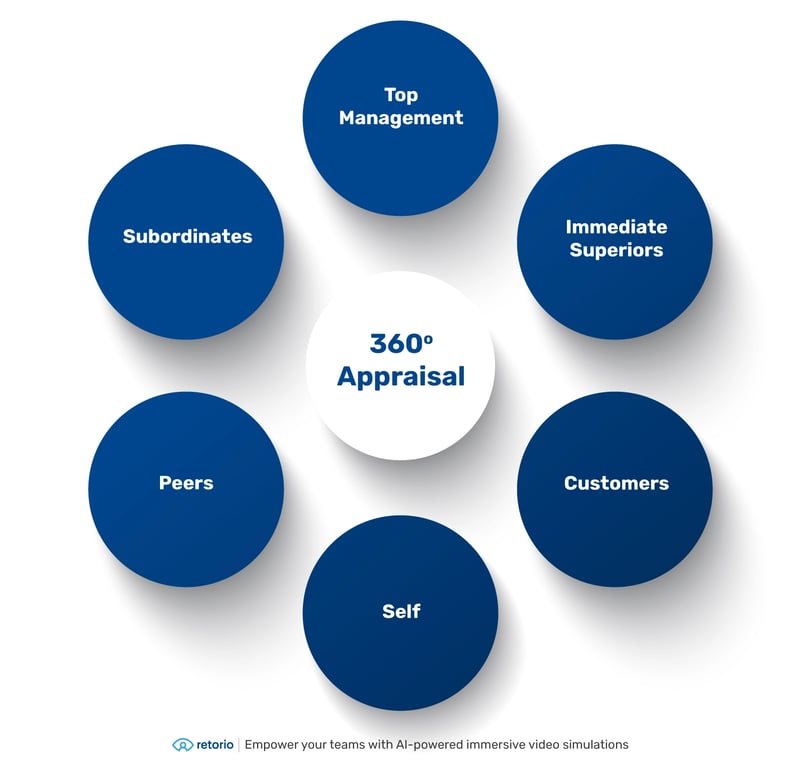We all know what a performance appraisal is, but what about a 360-degree performance appraisal? Sounds fancy, but the truth is - it's just like the standard performance appraisal, but more insightful and well-rounded.
It is simply another effective appraisal system that you can follow to get the best out of every performance appraisal. However, a 360-degree performance appraisal is more of a development tool than a rating tool and several organizations have integrated this performance review system to boost their employee's performance, employee engagement, and the professional development of their team.
According to a study on LinkedIn, more than 75% of respondents stated that receiving feedback is valuable to their job and career.
In this blog post, we will look into what a 360-degree performance appraisal is, how it works, as well as its pros and cons for you to see whether this method is worth implementing into your next performance review!
What's in this post?
What is a 360-degree performance appraisal?
Instead of highlighting the feedback received from the manager's and employee's point of view like in regular performance reviews, this method involves accumulating anonymous feedback and opinions from colleagues, other managers, and direct reports for the performance review. It is also known as a multi-rater feedback process.
The additional feedback here is used to provide each employee with a well-rounded and constructive feedback session that gives them a 360-degree overview of how they are perceived in the workplace.
Depending on their field of work, this method of performance feedback can also take insights from customers, and vendors if the employee engages with them on a regular basis. Gathering additional insights from people outside of the performance appraisal conversation can help managers receive more honest feedback on a certain employee's performance and help elevate the efficiency of the feedback process.
What are the 4 components of a 360-degree appraisal?
The four integral components of a 360-degree appraisal include the following:
-
Self-appraisal
-
Subordinate's appraisal
-
Superior's appraisal
-
Peer appraisal

How does 360-degree performance appraisal work?
The 360-degree feedback works by gathering feedback from a number of people within the organization that the designated employee interacts with the most. The feedback is polled using a standardized competency-based questionnaire. The questionnaire is comprised of scored questions based on a set of management competencies (e..g leadership skills, communication skills, and analytical skills).
The questionnaire also includes open-ended questions that the stakeholders can respond to. Open-ended questions allow stakeholders to elaborate on their working relationships with employees and provide feedback that is insightful to
But how does a 360-degree appraisal work? It consists of 6 steps (one optional step):
-
Step 1: Build a 360-degree outline for the appraisal. This means you should set performance criteria, the documentation required for the appraisal, and how you will notify your organization about the change.
-
Step 2: Implement HR software that automates the appraisal process.
-
Step 3: Request feedback from the relevant stakeholders (co-workers, managers, subordinates, other staff members, vendors, and anyone that the employee is in regular contact).
-
Optional Step: Include an opportunity for self-reflection. Despite this being an optional step, several organizations (Retorio included) strongly recommend this to be included as it allows employees to build on their self-awareness and reflect on how they can improve performance.
-
Step 4: Collect all the feedback results, and organize them in such a way that is easy to understand so that employees can receive them well. You can offer a summarized version of the accumulated feedback that does not include any specific details that may reveal who the feedback provider was. It is always best to stay impartial and let feedback simply stay as feedback. You wouldn't want employees to have an emotional response to feedback that is known to have been given by a specific client or coworker.
-
Step 5: Share the feedback with the employee and discuss with them how to create an effective action plan that will help them to develop their work performance.

Pros of the 360-degree performance appraisal
There are several benefits of using the 360-degree feedback process. Some of the basic, yet powerful benefits it holds are motivating employee engagement, and boosting morale.
According to research, more than 85% of Fortune 500 companies have adopted 360-degree reviews into their leadership development process.
Some other advantages of this evaluation technique are the following:
Provides a comprehensive evaluation
Since a 360-degree appraisal includes feedback that has been garnered by various sources of people, the array of feedback is much more diverse than a typical performance review. Therefore, this method has the potential to be more accurate and insightful, thus delivering a more comprehensive evaluation by being to easily identifying repeating patterns and themes in the feedback.
For example, if employees have received recurring negative feedback in a specific area of their work, managers can look into that more and discuss it more in-depth with their employees to figure out how to solve that issue. On the other hand, if employees have received constant positive feedback in another area of their work, it is a good idea for managers to focus on that and reward them for their efforts.
Therefore, as the number of feedback respondents increases, managers can gain better ideas and understanding of an employee's behavior, overall performance, and relationships. Employees are also more inclined to take feedback into proper consideration when it comes from multiple sources rather than just one.
Improves collaboration and productivity
What is better than improving collaboration and productivity than receiving feedback from your own team?
In theory, when a team is able to recognize all of their individual and team strengths and areas of improvement, they have the knowledge and incentive to make changes and improvements to become a better team player.
Employees become better workers and better collaborate with their team when they can understand what habits they need to acquire and improve on, resulting in a more productive and happy work environment.
In terms of collaboration and productivity, this performance review method can boost morale by helping employees and managers to work in harmony together. When utilized appropriately, 360-degree feedback can help to build a stronger foundation for trust, improve communication, and motivate teams to work together effectively to achieve common goals. It can also assist employees in aligning their goals with organizational values and gaining a clearer understanding of the skills required for long-term success.
The more feedback the better
It has been clearly emphasized by now that this performance review method contains a higher amount of feedback than one may usually expect, but feedback is never a bad thing. Therefore, the more feedback received, the better managers can evaluate an employee's performance and deliver constructive criticism.
This multi-rater feedback approach supports employees in their personal development by learning more about how their colleagues and clients perceive them and taking feedback more seriously than if it were just from their manager.
Determines training gaps
One of the best things that come out of a performance review is the new ideas for all things Learning and Development (L&D). Throughout the discussion that managers have regarding employee performance, skill gaps are often identified as an obstacle that some employees face when it comes to excelling in their tasks, and it is your role as the manager to find ways how you can help them bridge it.
Skill gaps can impact employees and the organization as a whole. Therefore, 360-degree performance management easily pinpoints areas where training programs should be cultivated to build up new strengths and promote the mindset of continuous improvement.
The best part is that since this method provides even more feedback than usual, managers can get a bigger and better overview of which areas were consistently lacking L&D development tools.
Encourages self-awareness
Being self-aware is one of the first steps to making positive changes in one's behavior. Therefore, with 360-degree feedback, employees can build a stronger sense of awareness about their strengths and areas of improvement. Building a new level of self-awareness can potentially inspire employees to concentrate more on self-improvement, develop new skills that are outside of their scope, and enhance their current skillsets to become even better at them, because why not? Continuous improvement mindset, remember?
Promoting this sense of self-awareness can help bridge the gap between how employees view themselves and how others perceive them because if the employee is not aware of where they lack, they will never be able to understand why they must change in the first place.
Provides insight into work
This is probably one of the most significant pros of the 360-degree assessment process: increased insight into an employee's role in the organization. It helps employees in seeing beyond their everyday tasks and outcomes and determines how their position in the company is contributing to the business.
Managers can also develop a better understanding of how an employee fits well within the team, and get a better glimpse of more nuanced feedback than merely completed work assignments.
The bottom line is - 360-feedback, truly is 360 degrees and you don't miss out on any valuable information. Every area is covered and it automatically builds on transparency and two-way conversations between the manager and employee as well as productive conversations with other company members.
Cons of the 360-degree performance appraisal
Every pros list comes with a con column to balance it out and of course, we have the little downsides covered:
Time-consuming
It is clear - the more insights you require, the longer the process takes. From sending out the feedback to waiting for the feedback responses (since team members and clients may take time to provide quality insightful feedback), and then waiting for HR employees to read through each feedback and organize it well, 360-degree performance appraisal can take up a significant amount of time. Especially if you want quality feedback, you wouldn't rush for it.
May lack positivity
While we all know that not every piece of advice can be positive, it can be tempting for managers to take advantage of 360-degree feedback to accentuate the negative aspects of an employee's performance instead of giving constructive feedback and encouraging employees to develop their performance and recognize the positive aspects.
Highlighting too much negative feedback can foster feelings of resentment, anger, or fear in the workplace. Therefore, managers should be mindful of this occurrence happening and focus on providing an equal balance of both negative and positive feedback. Try converting negative feedback into constructive criticism and negative remarks into motivating actionable statements.
Anonymity
Despite all feedback from stakeholders remaining anonymous throughout the 360-degree performance appraisal, many can take advantage of the anonymity and use this opportunity to lash out with personal feelings towards the employee in question, being overly critical or focused only on the weaknesses. To avoid this from happening, keep a good balance of questions that seek out the positive areas as well as what an employee can improve on rather than asking what an employee performs poorly in.
Here is a summary of the pros and cons listed above:
| Pros | Cons |
| Provides a comprehensive evaluation: easily identifying repeating patterns and themes in the feedback. | Time-consuming: The amount of time required to collect feedback, and wait for proper feedback responses along with organizing the feedback from HR can take a while. - But it's worth the wait! |
| Improves collaboration and productivity: helps to build a stronger foundation for trust, improves communication, and motivates teams to work together effectively to achieve common goals. | May lack positivity: can be tempting for managers to take advantage of 360-degree feedback to accentuate the negative aspects of an employee's performance. |
| The more feedback the better: Receiving more feedback supports employees in their personal development by learning more about how their colleagues and clients perceive them | Anonymity: Some employees may take advantage of anonymity and use this opportunity to give feedback based on personal feelings towards the employee in question, therefore lacking constructive criticism |
| Determines training gaps: identifies areas where training programs can be cultivated to build up new strengths and promote the mindset of continuous improvement. | - |
| Encourages self-awareness: Increasing self-awareness increases self-reflection which allows employees to want to become better performers | - |
|
Provides insight into work: helps employees in seeing beyond their everyday tasks and outcomes and determines how their position in the company is contributing to the business |
- |
There are numerous ways to conduct performance appraisals. The 360-degree method just happens to be one of them. Do you think it's worth implementing it into your next performance review? (We think so). Both you as the manager and employees can highly benefit from all that the 360-degree method has to offer. It is well-rounded and incredibly insightful.
It even allows employees to feel they are more engaged in the company if they are receiving feedback from other team members and clients as it shows them how they are contributing to the company's success.
Retorio understands the struggle of time-consuming methods, and we love nothing more than to streamline processes into ones that you will enjoy being part of. When it comes to performance appraisals, it takes practice to make perfect and Retorio does the "make perfect" part easy for you!
How? With our behavioral intelligence training platform, Retorio provides you with a library of high-quality training content that immerses you in real-life scenarios of what it is like to be sitting in a performance review. All with AI-powered role-play!
From what employees will ask you, to how you can best respond to them, Retorio has got it covered. Begin your journey now in acing performance appraisals with the click of the button below!
FAQ
The main purpose of a 360-degree performance appraisal is for managers to evaluate an employee's overall performance by receiving beneficial insights from superiors, peers, clients, and other team members. Instead of discussing feedback from 2 singular experiences (the employee and the manager), this appraisal method takes in additional feedback to provide a detailed review session.
Traditional performance appraisals deliver a more top-down approach that is centered highly on the manager's perspective only. This has the risk of the manager's bias influencing their feedback, whereas 360-degree feedback is more inclusive and focuses on receiving input from a range of sources to be more open in the process.



